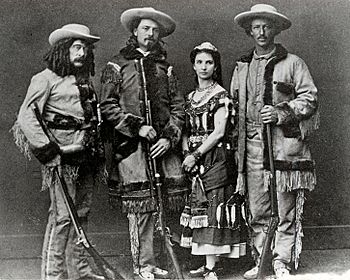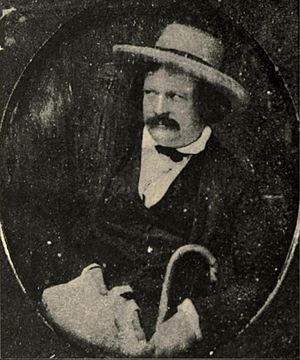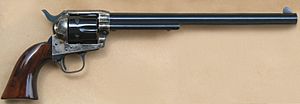Ned Buntline facts for kids
Quick facts for kids
Ned Buntline
|
|
|---|---|
 |
|
| Born |
Edward Zane Carroll Judson
March 20, 1821 Harpersfield, New York, U.S.
|
| Died | July 16, 1886 (aged 65) Stamford, New York, U.S.
|
| Occupation | Dime novelist; author |
| Spouse(s) |
|
| Children | Mary Carrolita Briggs, Irene Elizabeth Brush, Alexander McClintock, Edwardina McCormick, Irene A. Judson, Edward Z.C. Judson, Jr. |
Edward Zane Carroll Judson Sr. (born March 20, 1821 – died July 16, 1886) was an American writer and publisher. He was best known by his pen name, Ned Buntline. He wrote many popular adventure stories and helped make famous the legendary figure of Buffalo Bill.
Contents
Edward Judson was born in Harpersfield, New York, in 1821. His family moved to Bethany, Pennsylvania, and later to Philadelphia. His father, Levi Carroll Judson, was a lawyer. He hoped Edward would become a clergyman.
In 1834, Edward ran away from home and joined the Navy. The next year, he sailed on a Navy ship. In 1838, he saved people from a boat accident in New York's East River. Because of this brave act, President Martin Van Buren made him a midshipman (a junior officer in training). He served on several ships, including the USS Levant and the USS Constellation.
Edward served in the Seminole Wars as a sailor. After four years at sea, he left the Navy. Later, during the American Civil War, he joined the 1st New York Mounted Rifles and became a sergeant.
Becoming a Writer: Ned Buntline's First Stories
Edward Judson's first adventure story was published in The Knickerbocker in 1838. He spent several years starting newspapers and story papers in the East. Many of these did not last long.
One of his first big successes was The Mysteries and Miseries of New York. This was a serial story about life in the poorer parts of New York City. Edward had strong opinions. He supported movements like nativism (favoring native-born citizens) and temperance (avoiding alcohol). He also became a leader in the Know Nothing political group.
In 1844, he started using the pen name "Ned Buntline". A "buntline" is a type of rope used on a ship's sail. This name fit his adventurous spirit.
New Magazines and Moving Around
In 1844, Ned Buntline tried to start Ned Buntline's Magazine in Pittsburgh. He only published two issues before it closed. He then moved to Cincinnati and tried to buy another magazine, but that also failed.
Ned kept writing for other publications. In 1847, a publisher paid him to write exciting pirate novels. These included The Black Avenger of the Spanish Main and The Red Revenger. In 1848, he moved his own magazine, Buntline's Own, to New York City.
Ned Buntline was involved in the Astor Place Riot in 1849. This event led to many deaths. He was fined and spent time in prison for his part in it.
After his release, he focused on writing thrilling stories for weekly newspapers. He earned a lot of money from his writing. He also traveled the country, giving talks about the temperance movement. He was a strong supporter of the Republican Party for many years.
Ned Buntline and Buffalo Bill
Ned Buntline was traveling in Nebraska when he heard about Wild Bill Hickok. Buntline wanted to write a story about him. He found Hickok, but Hickok was not happy about being approached suddenly.

Buntline then met William F. "Buffalo Bill" Cody. This meeting happened around 1869. Buntline was giving talks about temperance when he met Cody, who had just been in a battle.
Buntline became friends with Cody. He later said he gave Cody the nickname "Buffalo Bill" for his serial novel, Buffalo Bill, the King of the Border Men. This story began in the New York Weekly in 1869.
Buntline first thought of Cody as a sidekick to Wild Bill Hickok. But he found Cody's character more interesting. Buntline's novel helped make Cody famous. In 1872, Buntline wrote a play called Scouts of the Prairie. Cody himself, along with Texas Jack Omohundro and others, performed in this play.
Cody was not sure about acting at first, but he grew to like being in the spotlight. Scouts of the Prairie opened in Chicago in December 1872. Critics did not like it, but it was very popular with audiences. The play was performed in many theaters across the country for years. Cody would work as a scout for the Army in the summer and then perform on stage in the winter. Buntline's play helped Cody prepare for his famous Wild West show later on.
Ned Buntline's Later Life and Legacy
Ned Buntline kept writing dime novels, but none were as successful as his earlier works. Later in life, he sometimes exaggerated his military career. He claimed to have been a chief scout in the American Indian Wars and to have been wounded many times. He also used other pen names like Captain Hal Decker and Scout Jack Ford.
Ned Buntline settled in his home in Stamford, New York. He passed away there in 1886 due to illness. He was once one of the richest writers in America. However, his wife had to sell his home, called "Eagle's Nest," to pay his debts.
Buntline's novels had a big impact. Some readers became very excited by the adventures of Western outlaws. For some, these stories made crime seem exciting.
The Buntline Special Revolver
A writer named Stuart N. Lake wrote in his book Wyatt Earp: Frontier Marshal (1931) that Ned Buntline gave special revolvers to Wyatt Earp and four other famous Western lawmen. These revolvers were said to be Colt Single Action Army guns with very long 12-inch barrels. They were called the Buntline Special.
According to Lake, Earp kept his revolver long, but the others cut their barrels shorter. However, modern researchers have not found proof that these special guns existed before Lake's book was published. There are no records from the Colt company or other historical documents that confirm this story.
Many historians still discuss whether Wyatt Earp truly owned a "Buntline Special." Even if the original story is not fully true, Colt later made many revolvers like the "Buntline Special" in the second half of the 20th century.




